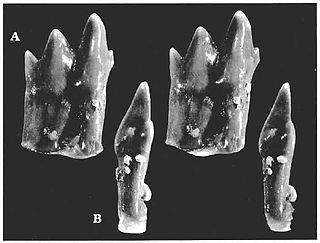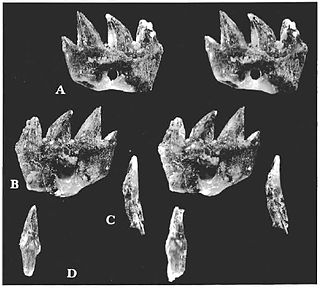 W
WGobiconodontidae is a family of extinct mammals that ranged from the mid-Jurassic to the early Late Cretaceous, though most common during the Early Cretaceous. The Gobiconodontids form a diverse lineage of carnivorous non-therian mammals, and include some of the best preserved Mesozoic mammal specimens.
 W
WEutriconodonta is an order of early mammals. Eutriconodonts existed in Asia, Africa, Europe, North and South America during the Jurassic and the Cretaceous periods. The order was named by Kermack et al. in 1973 as a replacement name for the paraphyletic Triconodonta.
 W
WDyskritodon is a genus of extinct mammal from the Early Cretaceous of Morocco, and possibly the Early Jurassic of India. Of uncertain affinities, it is tentatively described as a eutriconodont.
 W
WEutriconodonta is an order of early mammals. Eutriconodonts existed in Asia, Africa, Europe, North and South America during the Jurassic and the Cretaceous periods. The order was named by Kermack et al. in 1973 as a replacement name for the paraphyletic Triconodonta.
 W
WGobiconodonta is an order of extinct mammals known from the Early Jurassic to early Late Cretaceous. They are generally held to be part of Eutriconodonta.
 W
WIchthyoconodon is an extinct genus of eutriconodont mammal from the Lower Cretaceous of Morocco. It is notable for having been found in a unique marine location, and the shape of its teeth suggests an unusual, potentially fish-eating ecological niche. Analysis suggests it is part of a group of gliding mammals that includes Volaticotherium.
 W
WJeholodens was a primitive mammal belonging to the order Eutriconodonta, and which lived in present-day China during the Middle Cretaceous about 125 million years ago.
 W
WThe family Jeholodentidae is a possible eutriconodont family that was present in China around 125 million years ago during the time of the dinosaurs. There are currently two genera assigned to the family, Yanoconodon and Jeholodens.
 W
WPhascolotherium is a genus of extinct eutriconodont mammal from the Middle Jurassic of the United Kingdom. Found in the Stonesfield Slate, i was one of the first Mesozoic mammals ever found and described, although like the other mammal jaws found at the same time, it was mistakenly thought at first to be a marsupial.
 W
WRepenomamus is a genus of opossum-sized to badger-sized gobiconodontid mammal containing two species, Repenomamus robustus and Repenomamus giganticus. Both species are known from fossils found in China that date to the early Cretaceous period, about 125-123.2 million years ago. R. robustus is one of several Mesozoic mammals for which there is good evidence that it fed on vertebrates, including dinosaurs, though it is not possible to determine if it actively hunted live dinosaurs or scavenged dead ones. R. giganticus is among the largest mammals known from the Mesozoic era.
 W
WTriconodon is a genus of extinct mammal from the Early Cretaceous of England and France with two known species: T. mordax and T. averianovi. First described in 1859 by Richard Owen, it is the type genus for the order Triconodonta, a group of mammals characterised by their three-cusped (triconodont) molar teeth. Since then, this "simplistic" type of dentition has been understood to be either ancestral for mammals or else to have evolved multiple times, rendering "triconodonts" a paraphyletic or polyphyletic assemblage respectively, but several lineages of "triconodont" mammals do form a natural, monophyletic group, known as Eutriconodonta, of which Triconodon is indeed part of.
 W
WTriconodontidae is an extinct family of actively mobile mammal, endemic to what would be North America, Europe, Africa and probably also South America and Asia during the Jurassic through Cretaceous periods at least from 190–70.6 mya. They are distinguished from amphilestids and gobiconodontids due to their occlusion patterns: instead of interlocking molars, triconodontids fit their teeth more directly, with lower cusp "a" occluding anteriorly to upper cusp "A", between "A" and "B".
 W
WVolaticotherini is a clade of eutriconodont mammals from the Mesozoic. In addition to the type genus Volaticotherium, it includes the genera Argentoconodon, Ichthyoconodon, and potentially Triconolestes.
 W
WVolaticotherium antiquum is an extinct, gliding, insectivorous mammal that lived in what would become Asia during the Jurassic period, around 164 mya. It is the only member of the genus Volaticotherium.
 W
WYanoconodon is a monotypic genus of extinct early mammal whose representative species Yanoconodon allini lived during the Mesozoic in what is now China. The holotype fossil of Yanoconodon was excavated in the Yan Mountains about 300 kilometres from Beijing in the Qiaotou member of the Huajiying Formation of Hebei Province, China, and is therefore of uncertain age. The Qiaotou Member may correlate with the more well-known Early Cretaceous Yixian Formation, and so probably dates to around 122 Ma ago.